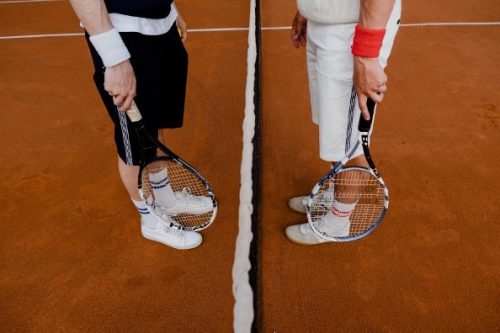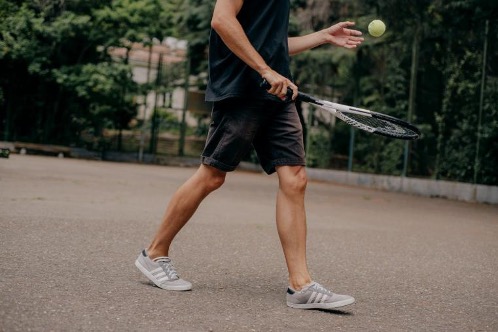What is a tennis elbow?
Tennis elbow or lateral elbow pain is an inflammation of muscle tendons. It affects the forearm and the elbow. Tennis players often suffer from this condition because it’s associated with the repetitive movement of the elbow joint. About 50% of tennis players get this condition in their lifetime. In the US, about 1 to 3% of the population also get tennis elbow.

Etiology
Lateral elbow pain is caused by overuse injury due to repetitive use of the elbow. This is a result of tasks and activities that require overuse of the elbow joint such as loading or repeated gripping. It mostly occurs in tennis players, but anyone can get the condition if they constantly use their elbow to perform tasks. Other sports that require wrist extension, forearm supination and radial deviation also cause lateral elbow pain.
Who is at risk of getting tennis elbow?
The condition is caused by poor mechanics and overuse of the elbow joint. It affects anyone who regularly uses their forearms to perform vigorous activities. It can affect you during recreational and professional activities such as:
- Baseball players
- Softball players
- Bowlers
- Fencers
- Golfers
- Tennis players
- Squash players
- Pickleball players
- Racquetball players
It can also affect people in certain professions such as:
- Assembly line workers
- Auto mechanics
- Butchers
- Chefs
- Carpenters
- Cleaners
- Painters
- Plumbers
- Dentists
- Gardeners
- Landscapers
- Manicurists
- Musicians
What is the cause of tennis elbow?
The primary cause of tennis elbow is a repetitive movement of the arm. Incorrect movement or overuse of the elbow causes tears in the tendon attachment. For example, in tennis, it’s caused by repeated motion and force used to hit the ball with a racquet. Incorrect motion increases the pressure on the tendon, causing irritation and inflammation. The extensor muscles become sore and painful due to the tendon breakdown. The condition is associated with the excessive extension of the fingers and wrist.
Other causes of the condition include:
- Overusing scissors
- Cutting tough food
- Gardening
- Sporting activities that require a lot of throwing such as tennis
- Swimming
- Manual work that needs repetitive turning or lifting, such as typing, plumbing, or bricklaying
 Some basic ways to prevent tennis elbow (elbow compression sleeve)
Some basic ways to prevent tennis elbow (elbow compression sleeve)
To prevent the condition, some minor changes might be needed during sports or strenuous activities. The following precautions will help avoid tennis elbow:
- Try to keep your arms strong and flexible. You can do this through strength training exercises at the gym or at home. Do some warm-up, stretch before activities or sports. Get used to exercises that make the same hand motions over and over
- During activities, avoid using repetitive movement or the incorrect technique
- Before playing any sport, ensure you check all the equipment to ensure it’s the right size and weight
- Don’t work in pain. Whenever you experience any pain it’s a way of your body giving you a warning and you should listen. Working in pain can lead to more damage of the tendons and tearing
- Another tip would be to wear an elbow compression sleeve as you work. It helps by keeping the muscles tight and together, preventing potential tearing
- Whenever you have any elbow pain, ensure you visit a professional doctor for a checkup and treatment of the symptoms
Treatment of Tennis Elbow
The type of treatment depends on the severity of the condition and it can be non-operative or surgical management. For non-operative management, there is a collaboration between yourself and professionals. The easiest way to manage lateral elbow pain is through resting after strenuous activity or when you’re experiencing pain. You can also apply ice on the elbow after the activity. If in pain, use oral or topical NSAIDs to relieve the pain. If you’re constantly doing activities that increase the risk of getting tennis elbow, always wear an elbow compression sleeve. It’s prescribed to relieve any tension at tendons, thus preventing injury. However, some patients report that the sleeve causes pain over the area of pressure due to the mechanical compression of the sleeve.
You can also try occupational or physical therapy that focuses on the forearm. Forearm stretching, strengthening and eccentric muscle strengthening of the extensor tendon have been helpful over the years. In case the pain fails to respond to these non-operative measures, more advanced techniques might be needed such as the use of nitrates, autologous platelet-rich plasma, botulinum toxin and dextrose prolotherapy.
You can also consider surgery if the pain is prolonged and severe. Additionally, if you have tried non-operative management for 6 to 12 months without success, consider surgical treatment. There are various surgical techniques but the common one is ECRB debridement and release of the tendon’s origin at the lateral epicondyle. A generous debridement is done at the tendon’s origin, to release tension in the area. Any torn tendons are debrided while ensuring healthy healing can take place thereafter.
Interesting Related Article: “The Importance and Benefits of Sports Medicine“

